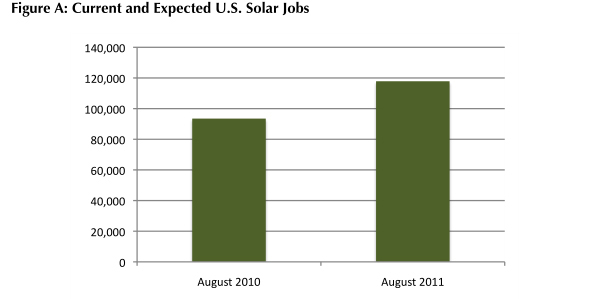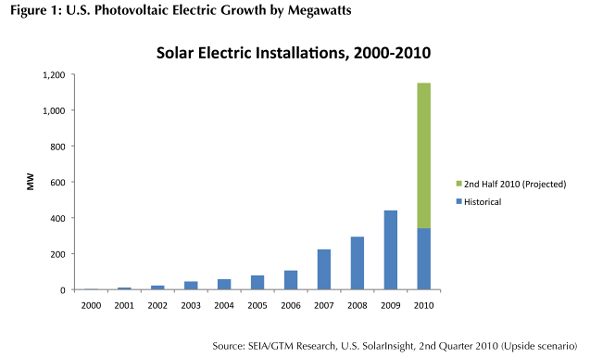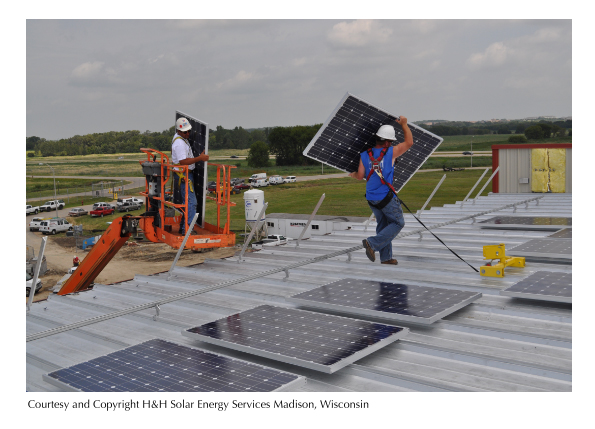The National Solar Jobs Census 2010 is the first attempt to quantify the current employment and projected growth of the United States solar industry and is based on a statistically valid sampling of employers throughout the nation.1 The rapid increase of solar energy generation has warranted a credible study that examines the size and scope of the industry that until now, has been lacking.
National Solar Jobs Census 2010
The Solar Foundation, a 501 nonprofit, non-lobbying organization funding solar research and education recognized this gap and worked with Green LMI Consulting, Cornell University and others to bring this important information to the foreground. This report represents an unprecedented effort to understand the solar industry’s labor market conditions and potential for growth.
In general, U.S. solar companies expect to add jobs at a pace that is much faster than the general economy, and are highly optimistic regarding their overall revenue growth over the near term. Specifically, as of August 2010, the U.S. solar industry employs an estimated 93,000 solar workers - defined as those workers who spend at least 50% of their time supporting solar-related activities. Over the next 12 months, over 50% of solar firms expect to add jobs, while only 2% expect to cut workers. This finding is especially relevant given that the overall expected 12-month growth rate for the entire U.S. economy is only about 2%.

Solar companies can be found in every state, and solar companies of all kinds expect to experience employment growth over the coming year. As would be expected, California is home to about 30% of all solar companies in the U.S., but other states, such as Colorado, Pennsylvania, Texas, Michigan, and Arizona report either large numbers of solar companies or large numbers of workers at solar-related firms. On a regional basis, the majority of the solar jobs are located in the West, followed by the Northeast, but jobs are growing quickly in all regions.
By comparing the job growth expectations from our research and from existing secondary sources, we can draw several important conclusions.
As of the end of August 2010:
- There are 93,502 solar workers in the United States, roughly double the number estimated for 2009.
- Solar job growth over the next 12 months is anticipated to be 26%, representing nearly 24,000 net new jobs. This expected growth rate is significantly higher than the U.S. economy-wide expectation of 2% growth over the same period.
- Nearly half of all firms expect their solar revenue to increase as a percentage of their overall revenue over the next year.
- Over half of all solar employers expect to increase their number of solar jobs in the next 12 months, while only 2% anticipate reducing solar staff.
- Solar jobs exist in all 50 states.
- Employers from all of the studied subsectors expect significant employment growth over the next 12 months.
- The average solar installation firm employs 8 solar workers.
- The average solar manufacturing firm employs 24 solar workers.
- The average solar wholesale trade company employs four solar workers.
- The average utility that generates solar electric power employs four solar workers.
These findings clearly illustrate that the solar industry is a strong and growing cluster that is responsible for thousands of jobs across every state in the nation. The unprecedented growth of the industry is providing much needed job creation despite an historic economic and workforce downturn. The optimism of solar employers in the midst of these conditions illustrates that job growth should continue for years to come.
Introduction
The solar industry is a strong and growing segment of our national economy. Over the past ten years, companies that design, manufacture, sell, install, and maintain solar systems have emerged in all regions of the United States, providing tens of thousands of jobs throughout the country. These employment opportunities span numerous industries and occupational titles, from skilled laborers to customer service and sales representatives.
In recent years, new technology, favorable legislative policies, and increased consumer demand for clean, renewable sources of energy have led to even more rapid growth of the solar industry. In fact, according to GTM Research, solar photovoltaic installations grew at a Compound Annual Growth Rate of 61% between 2006 and 2009. Despite gloomy general economic conditions in most sectors of our nation’s economy, the momentum generated by these trends has led to increased optimism about the potential for continued growth of solar jobs.

This report is a comprehensive analysis of U.S. solar labor market conditions. Unlike economic impact models that generate employment estimates based on revenue and other economic data and rely on jobs-per-dollar (or jobs-per-megawatt) assumptions, this report provides statistically valid and current data gathered directly from employers.
The primary and secondary data include information about all types of companies engaged in the production, sale, installation, and use of all solar technologies, ranging from photovoltaics to concentrating solar power to solar thermal systems for the residential, commercial and utility sectors.
The primary data contained in this report are drawn from a mixed-methodological survey using direct contact (phone and internet) with solar employers in the United States. Information was collected in July and August 2010 from both a measure of a so-called “known universe,” which includes firms from industry and government databases, as well as a random sample of businesses within various construction, wholesale trade, and manufacturing industries. This combined approach, together with a large sample size of nearly 2,500 survey completions, provides statistically valid results with a low margin of error (2.8-5.8% margin of error at 95% confidence level). This rigor allows us to draw broad conclusions about the solar industry with a high degree of confidence.
This report presents the information in several ways. The first section provides a national analysis of the primary data collection from each subsector of the solar value chain, including installation, wholesale trade, manufacturing, utilities, and all other firms. These conclusions are compared to national secondary data, which is presented in Appendix 5.3.
This National Solar Jobs Census 2010 has been conducted by The Solar Foundation and Green LMI Consulting, with assistance from BW Research Partnership. Cornell University provided technical assistance in reviewing and validating the entire process, from data collection through results analysis.
The research findings, which are being released for the first time in this report, provide stakeholders with timely and credible information to understand the solar industry’s labor market conditions and potential for further growth. This report is the first effort to collect primary data from employers about the size and scope of the solar industry and its workforce needs. These data are unprecedented and will hopefully inform future efforts of the U.S. Bureau of Labor Statistics to understand the solar labor markets.
It is important to note, however, that there are limitations to the data. Specifically, unlike economic models that generate employment estimates based on revenue and other economic conditions, the primary research findings in this report are drawn from actual survey responses by solar employers. Though this is a highly effective method for collecting real-time information, the employment estimates are based on those responses and therefore represent employers’ best estimates on how many jobs they expect to add over the coming year.
The employment growth rates provided in this report are high in comparison with other sectors over the same period. However, Green LMI Consulting and its partners have recently conducted numerous, separate regional reports using similar methodology and survey questions and have found the growth rates contained herein to be similar to those in other renewable energy sectors. At the same time, employers in other sectors, such as healthcare and information and communications technologies, are reporting much lower growth expectations (approximately 4% annual growth) when presented with similar surveys. Therefore, although we recognize that the data are based on employer estimates, solar employers in the United States are more realistically confident in their optimism about employment growth than their counterparts in other sectors.
The rest of the article PDF can be downloaded here.

The content & opinions in this article are the author’s and do not necessarily represent the views of AltEnergyMag
Comments (0)
This post does not have any comments. Be the first to leave a comment below.
Featured Product

